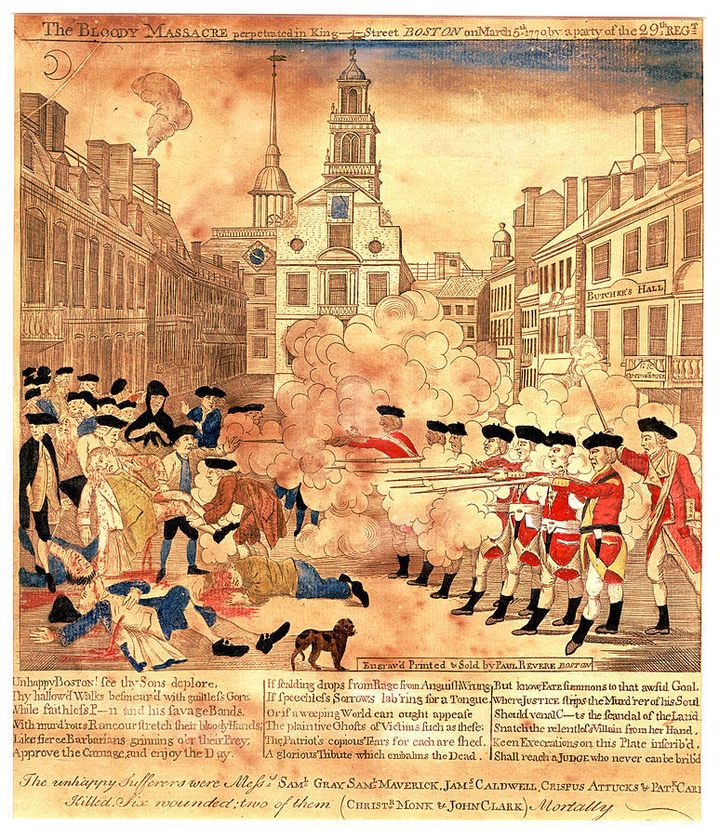Here in Boston, we celebrate Patriot’s Day each year in mid-April. For many folks that celebration is synonymous with the Boston Marathon, an enduring civic ritual that involves tens of thousands of people elevating their heart rates all the way from Hopkinton to Boston. But the first Patriot’s Day was no footrace; it took place on April 19th, 1775, when colonists battled British troops at Lexington and Concord. Paul Revere, in a ride made famous by fake history, was meant to have alerted the colonists but was stopped en route. It’s a problem with a long and proud pedigree.

Boston Massacre
“Fake history has always been a problem,” says Robert J. Allison, professor of history at Suffolk University in Boston. “And the only way to counter it is to do more historical research – to be able to challenge whatever the assumptions are behind fake history.”
Allison, the first guest on Dig Deeper, MindEdge Learning’s podcast on critical thinking and digital literacy, argues that misleading and downright fabricated historical narratives are nothing new. But he says today’s digital world demands greater vigilance than ever, because the Internet allows bad information to spread so quickly.
“Back in the 1880’s, Mark Twain said that a lie can be three times around the world before Truth gets its shoes on. It’s probably sped up now,” he observes.
A scholar of American history who specializes in colonial America and the Federalist period, Allison notes that Benjamin Franklin frequently used fakery as a form of political satire.
“This isn’t a new phenomenon; people have been doing this for a long time. With the advent of the printing press you see all kinds of hoaxes and things,” he recounts. “Benjamin Franklin wrote things for the newspaper – he wrote an Edict from the King of Prussia announcing he was going to be taking possession of the British Isles, because German people had moved there. Of course, he’s spoofing the British claims to governing America. But people read this in the London papers and they thought Frederick the Great was about to send a fleet to take them over. Then they realized this was a joke. Well, what if they hadn’t?”
Allison, who has written an acclaimed history of the Boston Massacre, notes that Revere wasn’t only the subject of fake history but engaged in some misrepresentations of his own—an 18th century version of fake news--as a way to stoke anti-British feeling among the colonists.
Revere produced a famous engraving of the fatal 1770 confrontation that became, in Allison’s words, “the most famous image of the American Revolution.” The engraving shows the British soldiers moving forward and firing on a retreating crowd. “This became the way people see this event,” he says. “[But] the judge at the time knew this wasn’t true. Even Revere knew this wasn’t true.”
Revere had, in fact, earlier drawn a diagram of the crime scene that showed the locations of the British troops and the bodies of their victims – a drawing that supported the British contention that the colonists were advancing on the troops, who were backed up against a wall. Revere’s diagram was later submitted as evidence in the trial of the soldiers, most of whom were acquitted.
“It’s really not at all the way Revere has it in the engraving,” Allison explains. “He knew that [the scene depicted in the engraving] wasn’t what happened, but this of course is much better propaganda than [the fact that] this crowd is attacking these soldiers.”
Revere’s misrepresentations are a classic example of the way that the historical record can be manipulated. “Usually when someone is promoting fake history, it’s really because they have an agenda not related to history but related to today,” he says. “Someone is doing something for a particular purpose. Revere certainly had a purpose; he wanted to inflame the public mind.”
Many of today’s attempts to alter the historical record likewise have a particular purpose. Internet sites that promote Holocaust denial, for instance, or the idea that the 9/11 attacks were an “inside job,” do so in the service of specific extreme ideological agendas. (Although, to be fair, many others are just looking to make a quick buck off the gullible.)
Fake history has been around for thousands of years: “It’s an old truism that the winners write history,” Allison says. “In China, of course, each new dynasty would rewrite history so that it was the center.” But the speed and ubiquity of the Internet amplifies the potential impact of bad information, and makes it more important that today’s generation does not take online sources at face value.
“The Internet makes it much easier to spread false information,” he notes. “Anyone who has access to a computer also can put up anything. And how do you, as someone reading this, know that this isn’t true, or that this actually is a credible source?”
In the final analysis, he says, students and researchers need to keep doing what they’ve always done: ask questions. Whether they’re at a computer terminal or in the library stacks, people need to maintain a healthy skepticism toward everything they read or view.
Alluding to a particularly infamous example of fake history – an anti-Semitic tract first published in Russia in 1903 – Allison observes, “One of the most pernicious books was The Protocols of the Elders of Zion, which existed long before the Internet. You do have to scrutinize everything, even if it’s in a book.”
